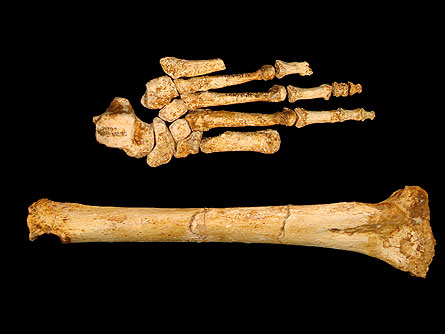Hobbit foot, hippo skulls deepen ancestral mystery
Fossil studies add some new twists to debate about a tiny, humanlike species
Fossil hobbits followed a simple motto: Walk, don’t run. That’s the implication of a new analysis of foot bones from an 18,000-year-old partial skeleton assigned to the controversial species Homo floresiensis, or hobbits.

But the relatively long and unusually primitive left foot of the female skeleton, known as LB1, feeds into growing confusion about the evolutionary origins of hobbits, researchers report in the May 7 Nature. So does another new investigation, of fossil hippo skulls, in the same issue.
“The hobbit foot could have made something like the more than 3-million-year-old Laetoli footprints in Tanzania but probably not the modern-looking footprints ascribed to 1.5-million-year-old H. erectus in Kenya,” says anthropologist William Jungers of StonyBrookUniversityMedicalCenter in New York (SN: 3/28/09, p. 14). Hobbits walked with a shuffling gait but would have had difficulty running, Jungers and his colleagues report.
LB1 stood at least a meter tall and displays primitive-looking skeletal traits from head to toe, Jungers says. H. floresiensis must have evolved from a species that was older, smaller and anatomically more primitive than Asian H. erectus, perhaps 2.4-million-year-old Homo habilis in Africa, Jungers proposes. An evolutionary transition from H. habilis to hobbits would have required little or no reduction in body size, in his view.
This proposal clashes with earlier interpretations of other hobbit fossils, also from the Indonesian island of Flores, that suggest a large-bodied H. erectus population from southeastern Asia evolved into H. floresiensis. H. erectus lived in southeastern Asia by 90,000 years ago, when hobbits first inhabited Flores. And other animals are known to have evolved into small species on islands, a process known as island dwarfing.
H. erectus could indeed have evolved a brain as small as that of LB1 via island dwarfing, assert Eleanor Weston and Adrian Lister, both paleontologists at the Natural History Museum in London. In support of that scenario, they report that two extinct dwarf species of hippopotamus from Madagascar possessed surprisingly small brains, based on a comparison with the modern-day hippo that evolved from the dwarf animals.
Weston and Lister studied fossil skulls of 36 pygmy hippos from species that died out about 6,000 years ago. Relative brain sizes of these creatures were as much as 30 percent smaller than would be expected by simply scaling down their larger evolutionary relatives.
These results, along with evidence of substantial brain-size reductions in island-dwarfed foxes (SN: 5/10/08, p. 7), suggest that H. erectus or another large-bodied ancestor could have evolved into hobbits, comments anthropologist Dean Falk of FloridaStateUniversity in Tallahassee. That ancestral species contributed humanlike brain traits to H. floresiensis (SN: 4/25/09, p.9), Falk hypothesizes.
But island dwarfing in hobbits could not have produced so many primitive skeletal traits, Jungers responds. Consider that, relative to leg length, LB1’s foot is proportionally as long as that of Lucy, a 3.2-million-year-old species in the human evolutionary family. Other primitive foot features of LB1 include long, curved toes; a stubby, chimplike big toe; and no arch.
Scientists who regard LB1 as a modern human who suffered from a brain-stunting developmental disorder, and not a separate species, remain unconvinced. LB1’s foot looks long in Junger’s analysis only because the foot is being compared with an extremely short upper-leg bone, says evolutionary biologist Robert Eckhardt of PennsylvaniaStateUniversity in University Park. An upper leg of that size — as well as many asymmetrically shaped head and lower-body bones — could have resulted from a developmental abnormality of some kind, Eckardt suggests.
Earlier comparisons of brain-size relationships in many mammal species, including island-living primates, indicated that LB1’s brain is too small to be that of an 18,000-year-old hominid, adds anthropologist Robert Martin of The Field Museum in Chicago. No data exist on relative brain size for a common ancestor of dwarf hippos and their mainland progeny, leaving Weston and Lister without a key comparison group, Martin notes.
The possibility that LB1’s many primitive skeletal features resulted from a developmental disorder “has not been seriously examined,” he says.







